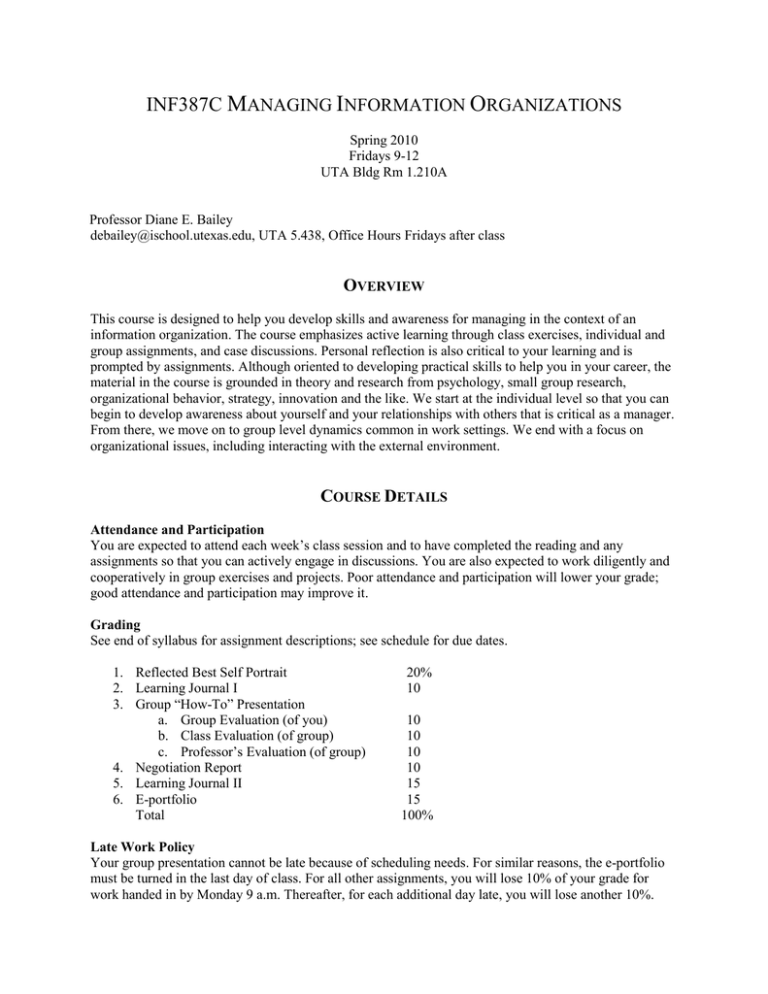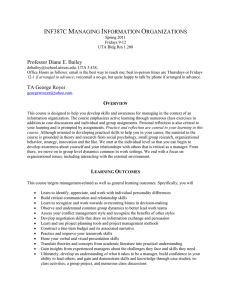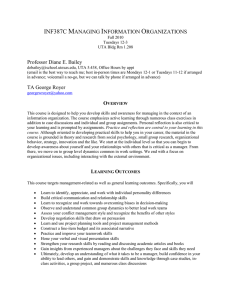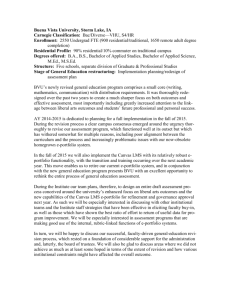M I O INF387C
advertisement

INF387C MANAGING INFORMATION ORGANIZATIONS Spring 2010 Fridays 9-12 UTA Bldg Rm 1.210A Professor Diane E. Bailey debailey@ischool.utexas.edu, UTA 5.438, Office Hours Fridays after class OVERVIEW This course is designed to help you develop skills and awareness for managing in the context of an information organization. The course emphasizes active learning through class exercises, individual and group assignments, and case discussions. Personal reflection is also critical to your learning and is prompted by assignments. Although oriented to developing practical skills to help you in your career, the material in the course is grounded in theory and research from psychology, small group research, organizational behavior, strategy, innovation and the like. We start at the individual level so that you can begin to develop awareness about yourself and your relationships with others that is critical as a manager. From there, we move on to group level dynamics common in work settings. We end with a focus on organizational issues, including interacting with the external environment. COURSE DETAILS Attendance and Participation You are expected to attend each week’s class session and to have completed the reading and any assignments so that you can actively engage in discussions. You are also expected to work diligently and cooperatively in group exercises and projects. Poor attendance and participation will lower your grade; good attendance and participation may improve it. Grading See end of syllabus for assignment descriptions; see schedule for due dates. 1. Reflected Best Self Portrait 2. Learning Journal I 3. Group “How-To” Presentation a. Group Evaluation (of you) b. Class Evaluation (of group) c. Professor’s Evaluation (of group) 4. Negotiation Report 5. Learning Journal II 6. E-portfolio Total 20% 10 10 10 10 10 15 15 100% Late Work Policy Your group presentation cannot be late because of scheduling needs. For similar reasons, the e-portfolio must be turned in the last day of class. For all other assignments, you will lose 10% of your grade for work handed in by Monday 9 a.m. Thereafter, for each additional day late, you will lose another 10%. MATERIALS YOU MUST ACQUIRE, THEIR PRICE AND SOURCE # 1 Item Reflected Best Self Portrait Exercise (129 Kb) (Get the exercise, not the booklet). Cost $6 Source https://www.bus.umich.edu/Positive/POSTeaching-andLearning/ReflectedBestSelfExercise.htm 2 Kroeger, O., Thuesen, J. M. & Rutledge, H. 2002. Type Talk at Work: How the 16 Personality Types Determine Your Success on the Job. Dell Publishing: New York. 12 Amazon or Co-op. 4 Harvard Business Press (HBP) Case: Managing a Global Team: Greg James at Sun Microsystems, Inc. (A) #409003PDF-ENG. 4 See link below. 5 HBP Case: Making RFID Work: The World’s Largest University Library RFID Implementation. #HKU866-PDFENG. 4 See link below. HBP Book Chapter (Austin et al.): Project management: What is the best approach to IT? 4 See link below. 6 Cialdini, R.B. 2008. Influence: Science and Practice, 5th Edition. Allyn & Bacon: Boston, Mass. 16 Amazon or Co-op. 7 HBP Case: Historical Society of Pennsylvania. #597062-PDF-ENG. 4 See link below. 8 HBP E-learning Case: Threadless: The Business of Community. #608707MMC-ENG. 7 See link below. 9 HBP Case: Transforming Singapore's Public Libraries (Abridged) #805028PDF-ENG. 4 See link below. 10 Hard copy dictionary. Cost of Course Materials - $61 Your choice (plus dictionary) Harvard Business Press Course Link: http://cb.hbsp.harvard.edu/cb/access/4906889 MATERIALS AVAILABLE ON COURSE BLACKBOARD SITE # 1 Item Goleman, D. 2000. Leadership that gets results. Harvard Business Review, 78 (2):108-116. 2 Manzoni, J.-F. & Bascoux, J.-L. 1998. The set-up-to-fail syndrome. Harvard Business Review, 76 (2):101-113. 3 Gabarro, J.I. & Kotter, J.P. 1980. Managing your boss. Harvard Business Review, 58(1): 92-100. 4 Garvin, D.A. & Roberto, M.A. 2001. What you don’t know about making decisions. Harvard Business Review, 79 (8):78-90. 5 Hammond, J. S., Keeney, R. L., & Raiffa, H. 1998. The hidden traps in decision making. Harvard Business Review, 76(5):47-58. 6 Maitlis, S. & Ozcelik, H. 2004. Toxic decision processes: A study of emotion and organizational decision making. Organization Science, 15(4): 375-393. 7 Edmondson, A.C. The Local and Variegated Nature of Learning in Organizations: A GroupLevel Perspective. Organization Science, 13(2): 128-146. 8 Hinds, P.J. & Bailey, D.E. 2003. Out of sight, out of sync: Understanding conflict on distributed teams. Organization Science, 14(6):615-632. 9 Jehn, K.A., Greer, L., Levine, S. & Szulanski, G. 2008. The effects of conflict types, dimensions, and emergent states on group outcomes. Group Decision and Negotiation, 17(6): 465-495. 10 Kanawattanachai, P. & Yoo, Y. 2007. The impact of knowledge coordination on virtual team performance over time. MIS Quarterly, 31(4): 783-808. 11 Allard. S. 2009. Library managers and information in World 2.0. Library Mgmt, 30(1):57-68. 12 Birdsall, W.F. 1990. The library manager as therapist. J. of Academic Librarianship, 16(4): 209212. 13 Mackenzie, M. L.& Smith, J.P. 2009. Management education for library directors: Are graduate library programs providing future library directors with the skills and knowledge they will need? Journal of Education for Library and Information Science, 50(3): 129-142. 14 Schacter, D. 2005. How to create a realistic budget. Information Outlook, 9(9):10-11. 15 Barthélemy, J. 2001. The hidden costs of IT outsourcing. MIT Sloan Management Review, 42(3): 60-69 16 Amabile, T. M. 1998. How to kill creativity. Harvard Business Review, 76(5): 76-87. 17 Kane, G. C., Fichman, R. G., Gallaugher, J. & Glaser, J. 2009. Community relations 2.0. Harvard Business Review, 87(11): 45-50. WEEKLY CLASS SCHEDULE Wk 1 INDIVIDUAL 2 Topic In-Class Activities Introduction: Learning in Action, Skills You Will Gain, How to Prepare for and Participate in Class Individual Differences: Understanding Yourself and Others 3 4 Explanation of assignments Quiz (already!) “House of Your Dreams” exercise Core self evaluation scale Tolerance of ambiguity scale Managing Relationships and Communicating with Others Tower exercise Paper tearing exercise Silence exercise Listening exercise How Individuals Make Decisions (and Why They Make Mistakes) Dollar Auction Gorilla Basketball video Results of Day 1 Quiz Self Portrait Discussion Items to Do/Read Prior to Class (see tables above for full citations) Read syllabus online, get course materials Kroeger et al. 2002. Type Talk at Work. Read Chs. 1-10 plus Section III, the 16 profiles. Complete the personality evaluation in Ch. 2, Kroeger et al. Due in Class Be ready with your completed personality evaluation. Reflected Best Self Portrait Goleman. 2000. Leadership that gets results. Manzoni & Baroux. 1998. Set-up-to-fail syndrome. Gabarro & Kotter. 1980. Managing your boss. Garvin & Roberto. 2001. What you don’t know about making decisions. Hammond, Keeney, & Raiffa. 1998. The hidden traps in decisionmaking. Wk 5 6 GROUP 7 8 9 10 Topic How Groups Form, Learn, & Make Decisions In-Class Activities Why Conflict Arises and What to Do When It Does What Happens When Workers are Distributed Across Time and Place Thoughtful Visionaries and Voices of Experience: Advice for the Future Information Manager Items to Do/Read Prior to Class Sugar exercise Desert survival exercise Group brainstorming Fishbowl Conflict exercise Conflict self assessment Case discussion Distributed meeting fishbowl Expert panel “How to”: Give a Presentation Group Prep Due in Class Maitlis & Ozcelik. 2004. Toxic decision processes: A study of emotion and org’l decisionmaking. Edmondson. 2002. The Local and Variegated Nature of Learning in Org’ns: A Group-Level Perspective. Hinds & Bailey. 2003. Out of sight, out of sync: Understanding conflict on distributed teams. Jehn et al. 2008. The effects of conflict types, dimensions, and emergent states on group outcomes. Case: Managing a Global Team: Greg James at Sun Microsystems, Inc. (A). Kanawattanachai & Yoo. 2007. The impact of knowledge coordination on virtual team performance over time. Allard. 2009. Library managers and information in World 2.0. Birdsall. 1990. The library manager as therapist. Mackenzie and Smith. 2009. Management education for library directors: Are graduate library programs providing future library directors with the skills and knowledge they will need? SPRING BREAK GROUP PRESENTATIONS GROUP PRESENTATIONS Learning Journal I ORGANIZATION Wk Topic 11 Project Management: New Technology Implementation 12 Negotiating with and Persuading Others $2 Negotiation game Discuss book Negotiation quiz Airport package exercise Tinmen excerpt Group agreement on negotiation exercise Cialdini. 2008. Influence: Science and Practice. 13 Coping with Change in Hard Times Case discussion Budget making Discussion of your negotiations Case: Historical Society of Pennsylvania. Schacter. 2005. How to create a realistic budget. Barthelemey. 2001. The hidden costs of IT outsourcing. Negotiation Sparking Creativity, Learning and Innovation Doodle exercise Candle exercise Random word exercise Discuss case and reading Case: Threadless: The Business of Community. Amabile. 1994. How to kill creativity. Learning Re-Inventing the Organization and Managing Public Relations Case discussion Sum up course 14 15 In-Class Activities Case discussion Desk Set excerpt Items to Do/Read Prior to Class Case: Making RFID Work: The World’s Largest University Library RFID Implementation Austin et al. 2009. Project management: What is the best approach for IT? Due in Class Report Case: Transforming Singapore's Public Libraries (Abridged) Kane et al. 2009. Community Relations 2.0 Journal II Bring a hard copy dictionary! E-portfolio ASSIGNMENTS You must complete six assignments for this course, as listed here in chronological order and described in detail below: 1. 2. 3. 4. 5. 6. Reflected Best Self Portrait Learning Journal I Group “How-To” Presentation Negotiation Report Learning Journal II E-portfolio Reflected Best Self Portrait This exercise is to help you recognize your strengths by soliciting opinions from the people who know you best. It requires that you ask 15-20 people for input, which you then analyze and summarize, so you need to get started right away. The instructions are included in material put together by professors at the University of Michigan. You should visit the link below to purchase the material online. Be careful: Make sure you order the EXERCISE (129 KB), not the booklet (618 KB) – both are $6. https://www.bus.umich.edu/Positive/POS-Teaching-and-Learning/ReflectedBestSelfExercise.htm Learning Journal I and II Keeping a learning journal helps you to be more reflective of what you are learning, what value this learning has for you, and what more you want to or should learn. You should write in your learning journal at least once a week. A learning journal is a place to record questions that come to your mind (perhaps during class or in your reading), interesting ideas from classmates, reflections on what you have learned so far, thoughts on how this course material relates to other courses or to other knowledge you have, thoughts sparked by class discussion that may not be fully formed yet, lists of topics you want to pursue in greater depth later, ideas for ways to gain or practice skills, topics you particularly like or dislike, worries that you have about yourself as a manager, and so forth. Although journal length may vary greatly from student to student, in general, you should write a couple pages per week in your learning journal. You will turn in your learning journal twice. Each time, you must write up separately answers to the following questions and hand in your answers with your journal. Your journal should contain evidence that your responses to these questions are based at least in part upon journal entries. Questions for Learning Journal I (week 8) What is at least one key idea I learned in each of weeks 2-7? (List separately by week and topic.) In what skill areas related to individuals and groups are my own skills not that strong? What are my strategies for improving my skills in these areas over the next year? How will I know if I have achieved each goal? Questions for Learning Journal II (week 14) What is at least one key idea I learned in each of weeks 8-13? (List separately by week and topic.) What was the most interesting or valuable group presentation I heard and why? (cont’d on next page) In what skill areas related to organizations are my own skills not that strong? What are my strategies for improving my skills related to organizations in the near future? (As a student, you come into contact with individuals and groups frequently, so you can work on those skills while still in school. You may not have the same level of opportunity for skills related to organizations, so your planning in this regard may be more distant.) How will I know if I have achieved each goal? How will I continue learning about and gaining management skills as I go forward? Group “How-To” Presentation In small groups, you will research one of the topics below, to be assigned in class based on group preferences. Your group will give a 20-minute “how-to” presentation to the class in Week 9 or 10. Your group is to act as a high-level management team giving a talk in your organization’s monthly lunch meeting attended by all managers and supervisors (your classmates). Your objective is to educate the managers and supervisors, help them begin to develop skills in the topic area, and help them retain what they learn in your presentation. A 5-minute question-andanswer period that you will moderate will follow your presentation. You must complete the following tasks at a minimum: (1) research the topic thoroughly, including the best academic and practitioner material you can find, (2) evaluate (prune) the material to determine what you want to cover, (3) develop an effective verbal presentation (4) practice your presentation as a group, (5) deliver it to the class. Everyone in your group must participate meaningfully in all tasks. You are limited to two sheets of handouts, which may be double-sided. Employ a layout that will facilitate retention and later reference, not one that will cram in additional, uncovered material. You may use whatever presentation technologies you wish, with the caveat that you are asked to practice their use prior to the presentation day to ensure they work smoothly. You are encouraged to be creative, for example by using a skit, making a movie, developing a quick exercise, role playing, and the like. Just remember that your creativity, like every other aspect of your presentation, should be aimed at the objective articulated in the first paragraph. You will be evaluated on this project along two lines: (1) how well you worked on your team (as evaluated by your fellow team members) and (2) how well your team helped the class learn this material (as evaluated by the class and the teaching staff). Evaluation sheets are included at the end of the syllabus so that you fully understand the relevant metrics. “How-To” Topics Interviewing a Potential Hire Coaching People Conducting an Employee Performance Evaluation Dismissing an Employee Delegating Work Managing Volunteers Managing Across Generations Managing the Use of Mobile and Social Networking Technologies at Work Running a Meeting Managing Time and Stress Balancing Work and Family Soliciting and Evaluating Vendor Bids Maintaining Facilities Raising Money Writing a Successful Grant Proposal Building Corporate and Large Donor Relationships Bidding on Collections Managing Your Career Negotiation Report You must enter into a negotiation with someone to persuade that person to do something you think is impossible to convince him or her to do; your chosen objective must first be approved in the course of a class exercise on Week 12. Afterwards, write up your attempt in a 1-2 page report. Note with whom you negotiated (by role or position, not name), what you tried to persuade that person to do, the negotiation tactics you employed, the result, and your (brief) observations on the process. Success is great; reflective understanding is even better. E-portfolio The purpose of the e-portfolio is to help you prepare for your ideal professional job upon graduation. Your e-portfolio will give you a head start on articulating your management skills and career goals through the creation of a space to share your projects, papers, and resume. Your e-Portfolio must include the following items at a minimum: 1. Statement of Intent. List and explain your career and professional goals. Discuss how your UT education (e.g., specific courses), your undergraduate degree, your volunteer efforts, prior employment, and/or similar events and experiences reflect and helped shape your professional interests and how they will aid you in achieving your goals. Your statement should be no more than two pages long; think of the intended audience as a recruiter, hiring manager, or potential employer, but recognize that the act of writing the statement, much like your Reflected Best Self Portrait exercise and your learning journal, should aid in developing your professional self-awareness. 2. Links to samples of your papers and project work at the iSchool. 3. Resumé. (See workshops and guides at iSchool Career Services.) E-portfolio format: Web-based. Primarily text, but may also include multimedia as appropriate. Post your e-Portfolio on the Web using your iSchool account. NOTE: Please convert each file to an .html format to be viewed using a Web browser, and NOT as specific file formats such as .doc, .rtf, or .pdf that download to the viewer's desktop. For more information on creating your own web pages see the iSchool Web Development tutorials. Post the URL to your e-portfolio to the forum with that name. I will evaluate your e-portfolio against these criteria: Establishes your unique strengths, talents and interests. Clearly and professionally communicates your goals, experiences, and work samples. Reflects excellent proof-reading, attention to detail and care for readers’ impressions through the absence of spelling and grammar mistakes. Demonstrates sufficient technical skill through the display and proper functioning of all elements of your e-portfolio site. GROUP PRESENTATION EVALUATION Group Topic ___________________________________________________________ Evaluated By___________________________________________________________ Provide a score from 1 to 5 for each element below according to the following scale: 5 4 3 2 1 Absolutely, Well Done Pretty Much So, Just a Few Issues More or Less, Neither Very Strong Nor Very Weak Not Exactly, Some Key Weaknesses Not at All, Highly Problematic Organization Score ______ Was the material organized coherently, with clear relationship between ideas, sound segues between sections, and strong introduction and conclusion? Content Score ______ Did the material seem on target for the topic? Did the team cover the topic sufficiently? Delivery Score ______ Was the verbal delivery good in terms of pace, volume, intonation and the like? Was the nonverbal delivery good in terms of confidence, gestures, movement, use of space, eye contact, and the like? Visual Aids Were the visual aids helpful, supportive, clear and easily understood? Engagement Score ______ Was the presentation interesting? Was it creative or innovative in its style? Objectives Score ______ Score ______ Did the presentation meet its intended objective to educate managers and supervisors and to help them begin skill development in the topic area? Did it meet its intended objective to help managers and supervisors retain what they learned in the presentation? Total Score (max 30) ______ GROUP MEMBER EVALUATION Group Topic ___________________________________________________________ Evaluation of Member ___________________________________________________ Evaluated By___________________________________________________________ Provide a score from 1 to 5 for each element below according to the following scale: 5 4 3 2 1 Absolutely, Well Done Pretty Much So, Just a Few Issues More or Less, Neither Very Strong Nor Very Weak Not Exactly, Some Key Weaknesses Not at All, Highly Problematic Creativity and Energy Was the individual an innovative problem solver and idea generator? Did he or she generate enthusiasm and exude positive energy to help the group complete its task? Collaboration Score ______ Was the individual able to hear others’ points of view? Did he or she share information, articulate arguments clearly, give constructive feedback, and handle criticism well? Responsibility and Organization Score ______ Was the work that the individual contributed to the group project done on time and to the level expected? Communication Score ______ Did the individual help and coach others, ensure that all parts of the presentation made a seamless whole, recognize the value of each person’s contribution, handle conflict well, and work to build consensus? Individual Contribution Score ______ Score ______ Did the individual commit enough time and effort to the project? Did he or she take initiative, plan tasks, respect others’ time, help the group make decisions, and work well under pressure? Total Score (max 25) ______


